Sai Kung Story
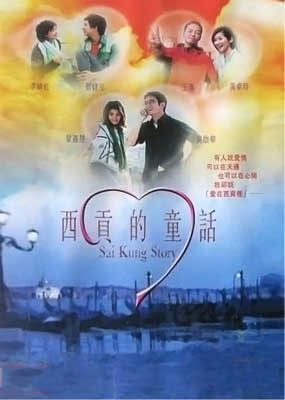
Reviewed by YTSL
In recent years, new technological changes have
taken place in the world of Hong Kong cinema. Of these, the most popular
may well be synch sound filming increasingly becoming the norm. On
the other end of the spectrum, the most reviled looks to be the resorting
by many low budget film-makers to shooting their works on digital video.
Despite my personal experience of them generally not being all that bad as
well as actually quite varied, I (too) have to admit to her tending to shy
away from most shot-on-video productions. This is not least because
the comments of many others have got me strongly suspecting that: worthwhile
works like “Women’s Private Parts” and “Gege” are few and far between; and
substandard efforts like “Hooker’s World” -- or uneven ones like that for
which the presence of Ruby Wong in its cast was what made me feel compelled
to check it out -- are more likely to be the rule instead.
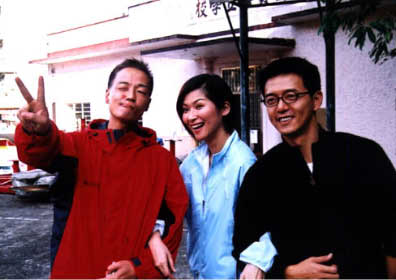
The largely filmed outdoors SAI KUNG STORY is
one of those movies -- like the more experimental “Heroes in Love” -- that
contains three distinct, non-intersecting narrative threads. The first
of these has Yoyo Mung playing Wing, a fish-bait seller in the sea-side village
of Po Tai O in Sai Kung District, and Lawrence Ng as a clothes designer named
Ching Lok who originally hailed from that section of Hong Kong but now spends
most of his time in the U.S.A. The second story has Patrick Tang in
its main role of a slacker postman who introduced himself to Theresa Lee’s
sad-eyed Gee character as Man (but then gets referred to more often in the
English subtitles as Michael Hui). Thus, it’s only in the third tale
that Ruby Wong makes an appearance -- as a widow named June: who continues
to dearly love her husband, Moon (essayed by Emotion Cheung), some three
years after his having prematurely passed away; and whose strong commitment
to his memory and family gets put to the test when Moon’s best buddy (Ming
is portrayed by Wong Hei) attempts to woo her away from them.
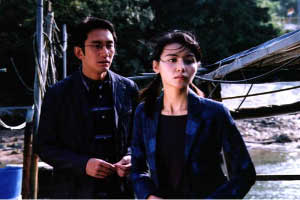
That which was screened in just one local theatre – but, in the process,
has the honor of being the first Hong Kong movie of 2003 – did not get off
to a particularly good start. Indeed, I’d go so far as to say that
the first SAI KUNG STORY was the least compelling. At the risk of upsetting
fans of “Running Out of Time”’s beloved ‘gal on the bus’, I’ll suggest that
this has a lot to do with Yoyo Mung’s having given a performance that looked
to have involved more posing than actual acting. To be sure, she was
not helped by her Wing character having been a rather shallow feeling plus
mercurial minded aspiring model (who is given to playing tricks on men who
seem to not want much more than her company, and developing a major grudge
against the person who accidentally splashed her with muddy water when he
drove past in his sports car). Nonetheless, the fact remains that,
despite his having less screen time than her, Lawrence Ng got me caring more
for his character’s attempt to stroll down Memory Lane in search of a flour
doll store than for Wing’s seeking to realize her ambitions to not “get stuck
in this place for the rest of my life” and “live an ordinary life”.
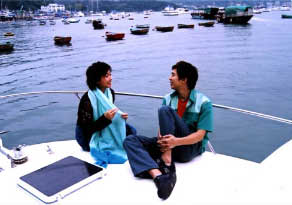
The second SAI KUNG STORY looks to take place in a more built-up section
of the New Territories district which includes the Clearwater Bay area made
famous by the Shaw Brothers, and begins with Patrick Tang’s character waking
up from a nap and finding that a bird has defecated on his face. Soon
after, this young fellow gets told off by his superior and gets informed
by a colleague that other postmen’s work load has increased as a result of
the mail that he frequently delivers to the wrong addresses needing to be
returned, resent, forwarded and such like. Still, it’s only after he
gets to know a woman (Theresa Lee’s Gee character) who anxiously awaits each
epistle from France that her boyfriend sends her, and makes the acquaintance
of another (Hidy Chan is played by Nicole Tam) who is expecting a letter
that “can turn around the future”, that he comes to realize that letters
“carry so much emotion”. And, yes, somewhere along the way, the reformed
personality does also fall in love himself...but I honestly think that’s
a less interesting component of this particular tale.
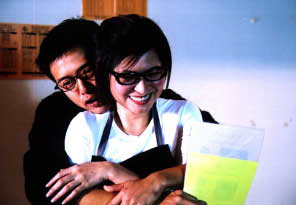
Like with the first SAI KUNG STORY, the third one has a Johnnie To discovery
as its female lead. IMHO, Ruby Wong’s luminous presence adds as much
to this offering as Yoyo Mung’s threatened to take away from it. As
in “Where a Good Man Goes”, this too often under-appreciated actress portrays
a widow. For all of her June character having spent the most recent
three years of her life without a husband (yet still toiling on behalf of
her in-laws), however, this is an individual who looked to have a sunnier
outlook than many of the others which Wong Siu Chea has essayed. Somewhat
ironically though, the return into June’s life of a mutual friend of hers
and her deceased husband’s ends up threatening what happiness she had managed
to have. As luck also would have it, it was the way that this tear-jerking
section of this B&S production -- more so than the two others -- got
resolved that ensured that I would feel much less satisfied post viewing
the movie as a whole than I had thought I would be as late as some seven
(or maybe even five) minutes from its end.
My rating for this film: 5.5





